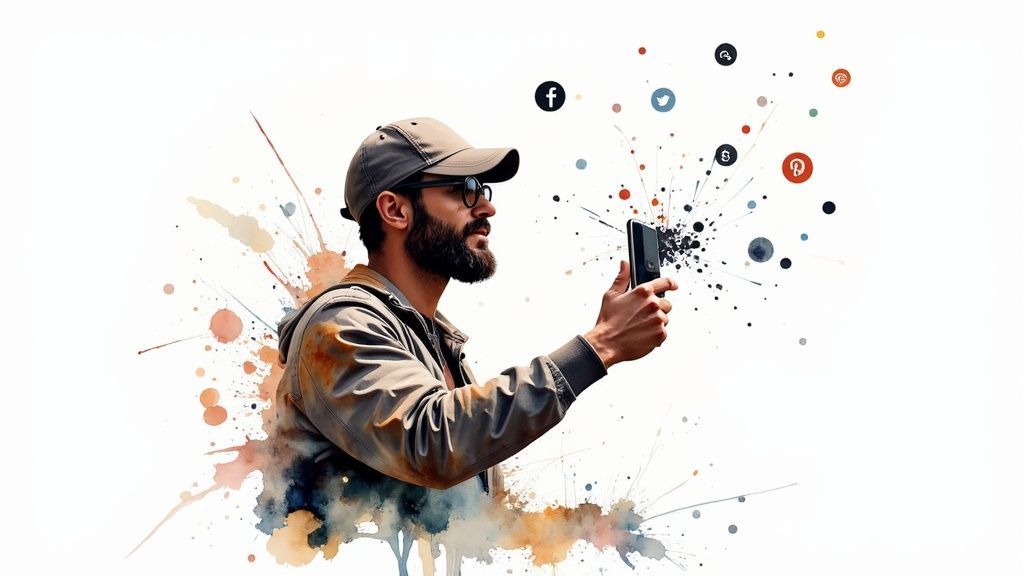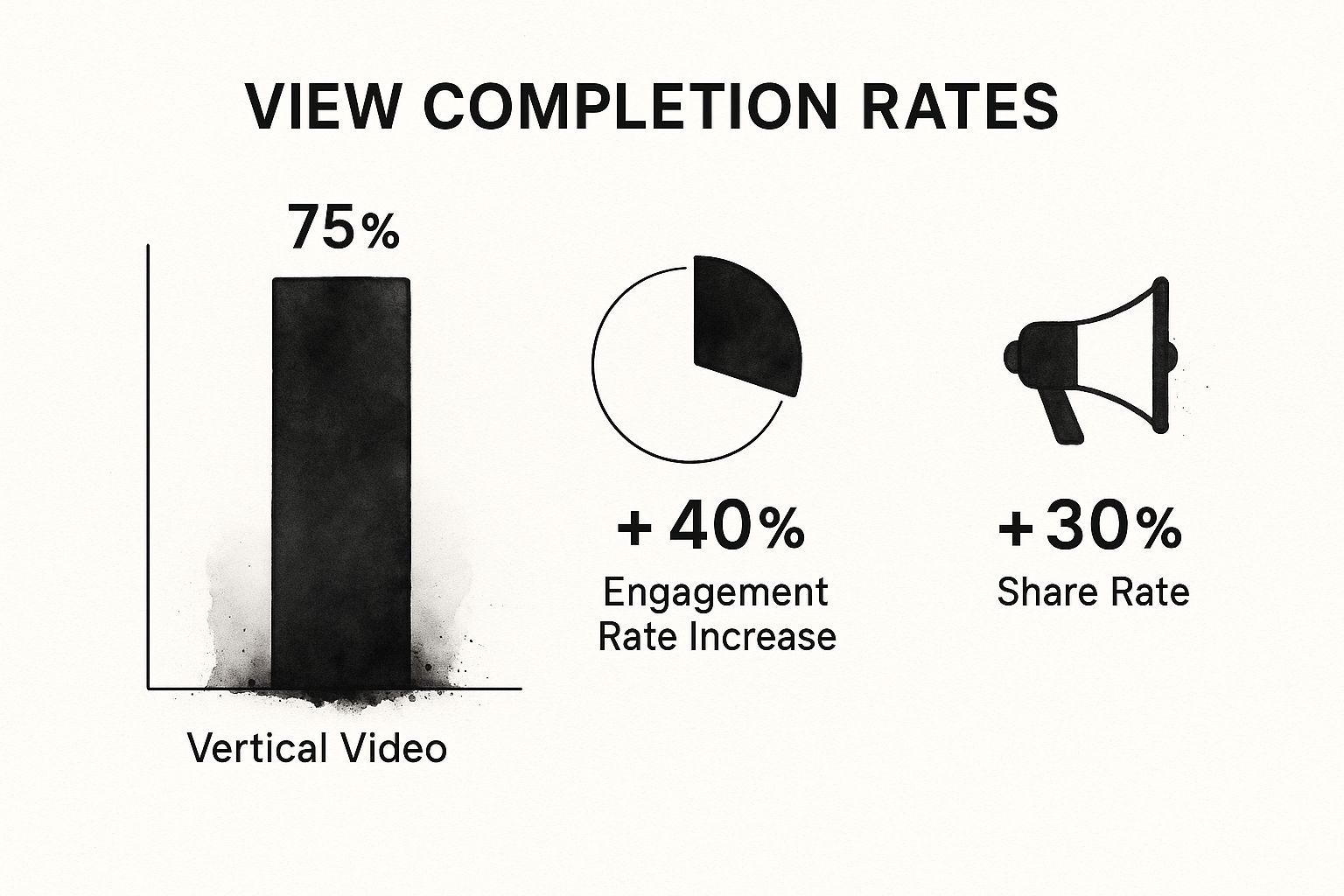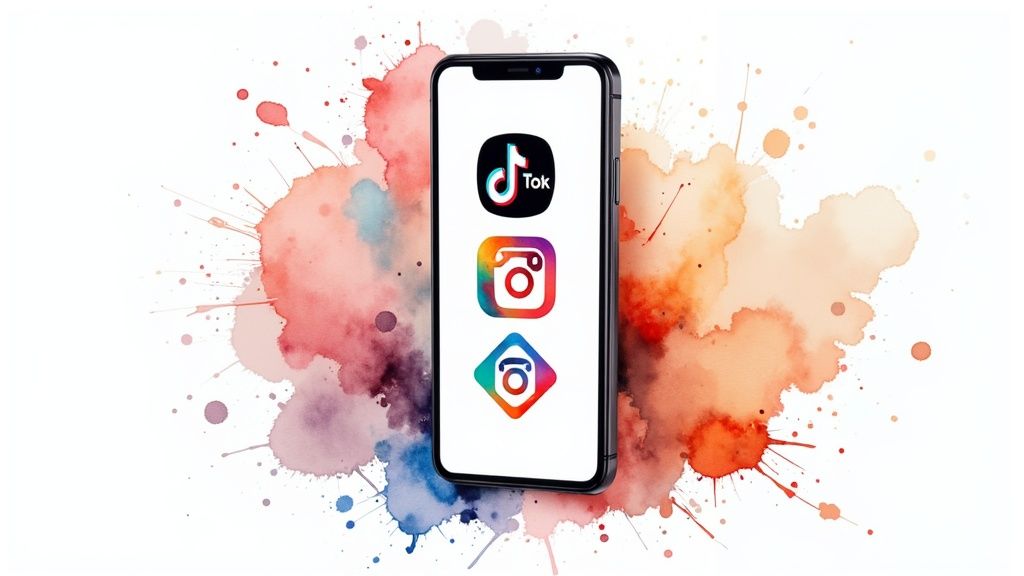Unlock the power of vertical video marketing. This guide covers why it matters, best practices, and successful examples to boost your mobile engagement.
In This Article
Subscribe to our newsletter
Think about how you hold your phone. Right now. Go ahead, pick it up. Chances are, you're holding it vertically. It’s just natural. This simple, everyday habit is the driving force behind one of the biggest shifts in digital marketing: vertical video.
This isn't just about rotating your camera 90 degrees. It’s a complete rethinking of how we create and share video content, designed from the ground up for the way people actually use their phones. We're talking about a mobile-first approach that powers platforms like TikTok, Instagram Reels, and YouTube Shorts. It's no longer just a trend; it's the new standard.
The Unstoppable Shift to Vertical Video

Remember when the world went from desktop to mobile? That wasn't just a screen-size change; it was a fundamental rewiring of how we connect and consume information. The rise of vertical video is having a similar impact.
Asking someone to turn their phone sideways to watch a video today feels like an interruption. It creates a tiny, almost subconscious, point of friction. Why make them do that? Vertical video removes that barrier, delivering a full-screen, immersive experience that perfectly aligns with how we live our lives now.
This Isn't a Passing Fad
The vertical format is a direct response to our digital habits. Platforms built entirely around it have trained billions of us to expect—and prefer—content that fills our screens from top to bottom. It’s the native language of mobile.
But this shift isn't just about aesthetics; it's about effectiveness. Vertical videos are inherently more immersive. By taking over the entire screen, they eliminate distractions, pull the viewer in, and make the content far more memorable.
The money is following the eyeballs. By 2025, global spending on digital video ads is expected to blast past $200 billion. A huge $111 billion of that is earmarked for short-form content—the kind that thrives in a vertical format. It’s no surprise that 95% of companies now see video as a core part of their strategy. If you want to see just how big this movement is, you can explore more key video marketing statistics on Wix.com.
Embracing the Vertical-First Mindset
Jumping into vertical video means more than just cropping your old landscape content. You have to start thinking in a taller frame from the very beginning. It's a different way of telling a story.
Here are a few things to keep front and center:
- Framing and Composition: The action needs to be centered and clear. You have to account for the platform’s interface—the icons, text, and buttons that will sit on top of your video.
- Pacing and Hooks: You have three seconds. Maybe less. In a fast-scrolling feed, you have to grab attention immediately or you’ll be swiped into oblivion.
- Accessibility: Design for sound-off viewing from the start. People often watch without audio, so clear, bold captions and on-screen text are non-negotiable.
Getting these elements right is what separates content that feels native and engaging from content that feels like a clunky afterthought. To get a handle on the technical side of things, our complete guide to vertical video dimensions is the perfect place to start. It will give you the foundation you need to create videos that truly connect.
Why Vertical Video Is a Mobile-First Imperative
The core reason vertical video has completely taken over is simple: it’s built for the way we actually live our lives. Just think about it for a second. We hold our phones vertically 94% of the time. Asking someone to flip their device sideways to watch your content is like handing them a small puzzle to solve before they can get to the good stuff. It’s a tiny, but very real, point of friction.
Vertical video gets rid of that friction completely. It meets your audience exactly where they are, in their natural scrolling habitat. This isn't just about convenience; it's a huge psychological advantage. When your content fills the entire screen, it commands total attention.
The Psychology of Full-Screen Immersion
A vertical video creates a truly immersive, full-screen world that pushes out all the other distractions on a phone. This isn't just about making the picture bigger; it's about creating a more focused experience. Your message gets the spotlight, free from the visual noise of notifications, browser tabs, or other on-screen elements that steal focus from horizontal videos.
This intense focus leads directly to better performance. When a viewer is completely absorbed, they’re far more likely to watch longer, connect with what you're saying, and remember your brand afterward. It's the difference between glancing at a poster on a crowded wall versus stepping into a private art gallery where only one masterpiece is on display.
The secret weapon of vertical video is the undivided attention it commands. It creates a more personal, direct line between you and the viewer, which boosts message recall and builds a much stronger emotional connection.
This graphic really drives home how much better vertical videos perform against their horizontal counterparts on key engagement metrics.

The data doesn’t lie. Simply changing the orientation can dramatically improve how many people watch your video to the very end and how willing they are to engage with it.
Vertical vs. Horizontal Video Performance Metrics
To really see the difference, let's compare how these two formats stack up on the platforms where it matters most. The numbers show a clear winner for mobile-first engagement.
| Metric | Vertical Video (e.g., Reels, Shorts) | Horizontal Video (e.g., Standard YouTube) |
|---|---|---|
| Completion Rate | Significantly higher; viewers are more likely to watch the full video. | Lower on mobile; users often drop off early. |
| Screen Real Estate | Fills 100% of the mobile screen for an immersive view. | Occupies only a small portion unless the phone is rotated. |
| Engagement (Likes, Comments) | Higher, as the format encourages quick, in-feed interaction. | Lower on mobile feeds; requires more user effort. |
| Click-Through Rate (CTR) | Generally higher due to prominent, easy-to-tap CTAs. | Often lower, as CTAs can be smaller or less visible. |
As the table shows, vertical video isn't just a trend; it's a format optimized for the metrics that drive real results on mobile.
Driving Business Results with Vertical Content
The advantages of this mobile-native format go way beyond just looking good on a phone. The better user experience and higher engagement rates translate into real, measurable business outcomes. A vertical-first strategy isn't just a creative choice anymore—it's a strategic must-do for growth.
Just look at the performance benefits:
- Higher Completion Rates: Because vertical video just feels right on a phone, viewers are way more likely to watch it all the way through. A completed view means your entire message lands.
- Increased Engagement: Social media algorithms are built to reward content that keeps people on the platform. Vertical videos, with their higher watch times and interactive feel, get a natural boost, leading to more organic reach.
- Better Click-Through Rates: A call-to-action in a vertical video feels less like an interruption. The full-screen layout makes buttons and links bigger and easier to tap, driving more traffic to your landing pages or product listings.
And this train is only picking up speed. It’s projected that video will make up a staggering 82% of all internet traffic by 2025, and you can bet most of that is happening on a phone. Considering that nearly 80% of users prefer to learn about products through short-form video, the path forward is clear. To get a deeper dive into these numbers, you can explore more insights on Teleprompter.com. Adopting a vertical-first mindset is simply essential for staying relevant and effective.
Key Platforms for Vertical Video Success
 Figuring out where to put your vertical video efforts is a lot more nuanced than just chasing the platform with the most users. It’s a strategic choice that really comes down to who you’re trying to reach, the kind of content you make, and what you want to achieve. Each of the big players—TikTok, Instagram Reels, and YouTube Shorts—has its own vibe, its own algorithm, and its own set of user expectations.
Figuring out where to put your vertical video efforts is a lot more nuanced than just chasing the platform with the most users. It’s a strategic choice that really comes down to who you’re trying to reach, the kind of content you make, and what you want to achieve. Each of the big players—TikTok, Instagram Reels, and YouTube Shorts—has its own vibe, its own algorithm, and its own set of user expectations.
Think of it like picking a venue. You wouldn’t host a high-energy rock concert in a quiet art gallery, right? In the same way, the exact video that blows up on TikTok could fall completely flat on Instagram. Getting a feel for these differences is the first real step to getting it right.
This means a one-size-fits-all strategy is off the table. To really connect, you've got to tailor your message to fit the unique environment of each platform.
TikTok: The Engine of Trend and Authenticity
Let's be clear: TikTok is the undisputed heart of viral trends and raw, unfiltered content. Its algorithm is legendary for a reason—it can launch an unknown creator into the stratosphere overnight. The audience here is primarily Gen Z and younger Millennials, a crowd that craves authenticity, relatability, and a good dose of humor.
The culture is all about participation. Winning on TikTok isn't about broadcasting; it's about jumping into the conversation. That means hopping on trends, using popular sounds, and making content that feels native to the platform, not like a slick corporate ad. In fact, overly polished videos tend to stick out like a sore thumb.
- Best for: Brands targeting a younger crowd, building community with user-generated content, and jumping on fast-moving cultural moments.
- Content style: Behind-the-scenes looks, funny skits, educational tips with personality, and challenge-based videos. Authenticity is the golden rule.
For any marketer serious about vertical video, it's worth digging into platform-specific advertising. Resources on TikTok Ads can offer crucial insights into its powerful paid advertising tools.
Instagram Reels: The Polished Storyteller
Instagram Reels lives inside the larger Instagram world, and that gives it a completely different flavor. While it looks a lot like TikTok on the surface, the content on Reels often feels more curated and aesthetically polished. People on Instagram are already used to high-quality photos and lifestyle content, and they bring that same expectation to video.
A huge advantage for Reels is its deep integration with the rest of Instagram. You can seamlessly share Reels to your Stories or main feed, tapping into the audience you've already built. The demographic is also broader than TikTok's, spanning from older Gen Z to Gen X and beyond, with big interests in fashion, food, beauty, and travel.
While authenticity is still a big deal on Reels, it’s often a more refined version. Think "aspirational authenticity"—content that's beautiful and inspiring, yet still feels personal.
YouTube Shorts: The Hub for Education and Entertainment
YouTube Shorts is Google’s play in the short-form game, and its superpower is its direct link to the world's second-largest search engine: YouTube itself. This makes Shorts an incredible tool for discovery, pulling in new viewers who might then stick around for your longer videos.
The content that really shines on Shorts often teaches or entertains in a "how-to" format. We're talking quick tutorials, fascinating facts, condensed product reviews, or highlight clips from longer videos. Since people often come to YouTube ready to learn something or be entertained, Shorts that deliver clear, quick value do exceptionally well.
This platform has a massive and incredibly diverse global audience, making it a viable option for nearly any industry, as long as the content is snappy and valuable.
Here’s a quick breakdown to help you see where your brand fits best:
| Platform | Primary Audience | Core Content Vibe | Key Strength |
|---|---|---|---|
| TikTok | Gen Z, Younger Millennials | Raw, Authentic, Trend-Driven | Viral potential and community building |
| Instagram Reels | Broad (Millennials, Gen X) | Polished, Aspirational, Visual | Integration with Instagram's ecosystem |
| YouTube Shorts | Extremely Broad, Global | Educational, Entertaining, Informative | Discoverability and driving traffic to long-form content |
Ultimately, the smartest approach might be using all three, but creating unique content that speaks the language of each platform. If you're just starting, pick the one where your audience hangs out the most, and focus on mastering its style first.
Best Practices for Creating Engaging Vertical Videos
Making vertical video that actually works isn't about having a Hollywood budget. It’s about speaking the unique language of the mobile feed. The old rules from traditional landscape video just don’t cut it in a world of fast-scrolling thumbs.
To succeed, you need to throw out the old playbook and embrace a new set of principles. These are all designed to grab fleeting attention and deliver value in the blink of an eye.
The single most important part of your video? The first few seconds. You have a razor-thin window—maybe one to three seconds—to give someone a reason to stop scrolling. If that hook doesn't land instantly, they're gone. That's the first and biggest hurdle you have to clear.
But once you’ve got their attention, you have to keep it. This means rethinking how you tell stories, focusing on clarity, momentum, and designing for how people actually use their phones.
Design For Sound-Off Viewing
Here’s a hard truth: a huge number of people watch social media videos on mute. They’re scrolling in public, during a meeting, or late at night when sound isn’t an option. If your entire message is in a voiceover, it’s going to be completely lost on a massive slice of your audience.
That’s why designing for a sound-off experience is absolutely essential. Your video needs to make perfect sense and still be engaging with the volume at zero.
- Use Bold Captions: Don't just rely on the platform's auto-captions, which can be wonky or ugly. Burn clear, easy-to-read captions directly into your video file so they're part of the visual experience.
- Leverage On-Screen Text: Think of text as a visual element. Use dynamic text overlays to pop key points, ask questions, or move the story forward. It keeps the eyes busy and reinforces your message.
- Show, Don't Just Tell: Let your visuals do the talking. Instead of saying a product is easy to use, show someone using it with a smile. Visuals are a universal language that doesn't need audio to be understood.
Master The Vertical Frame
The 9:16 aspect ratio is more than just a taller screen; it's a completely different way to compose a shot. What looks great in a wide 16:9 frame often feels awkward or claustrophobic when cropped vertically. You have to embrace the tall, narrow format.
Think of it like shooting a portrait. The focus should be tight and centered, usually on a person or a single, important object. Wide, sprawling shots are out—key details will get lost. You also have to be mindful of the app's interface, like the like and comment buttons that sit on top of your video.
Keep your main subject and any critical text or graphics inside a "safe zone" in the center of the screen. This ensures nothing important gets covered up by UI elements, keeping your video looking clean and professional.
Structure Your Story For Quick Consumption
Vertical videos live and die by a simple, punchy narrative: hook, middle, and call-to-action (CTA). There's no room for a slow, cinematic build-up.
- The Hook (1-3 Seconds): Lead with your most jaw-dropping visual, a challenging question, or a bold claim. The only goal is to jolt the viewer out of their mindless scroll.
- The Middle (5-20 Seconds): This is where you deliver the goods. Keep it fast-paced. Use quick cuts, moving text, and eye-catching visuals to hold momentum and get your point across efficiently.
- The CTA (Final 3 Seconds): Be direct. Tell them exactly what to do next. "Follow for more," "Shop the link in bio," or "Share your thoughts below"—a clear CTA is what turns a view into a valuable action.
When planning your content, pulling from a wide variety of practical social media post ideas can help keep your feed feeling fresh and unpredictable.
If you're ready to go deeper on storytelling and engagement, our guide on how to create engaging videos with proven strategies will give you a more advanced toolkit. Nailing these practices is what separates random content from a vertical video strategy that actually builds an audience and drives growth.
Overcoming Common Vertical Video Marketing Hurdles
 Let’s be honest: jumping into vertical video can feel like a huge undertaking. You see the incredible engagement other brands are getting, but you hesitate. Concerns about budgets, time, and the tech involved can stop a great idea in its tracks.
Let’s be honest: jumping into vertical video can feel like a huge undertaking. You see the incredible engagement other brands are getting, but you hesitate. Concerns about budgets, time, and the tech involved can stop a great idea in its tracks.
But here’s the good news. Those hurdles are much smaller than they look. The same mobile revolution that made vertical video a must-have has also made creating it easier than ever. You really don’t need a Hollywood studio or a massive budget to get started.
In reality, the biggest roadblock is often just figuring out where to begin. While a whopping 95% of marketers agree video is important, 37% of those not using it confess they simply don't know how to start. This uncertainty, coupled with a lack of time (26%) and budget worries (11%), is what holds most people back. You can dig into these trends and more powerful video marketing statistics on HubSpot.
Demystifying The Production Process
One of the most persistent myths about vertical video is that you need expensive gear. The truth? That high-powered camera you carry around in your pocket is more than enough to create fantastic content for platforms like TikTok and Instagram.
On these platforms, authenticity almost always beats high production value. Viewers are there for content that feels genuine and relatable, not a polished TV commercial. Your smartphone, some decent lighting, and clear audio are all you need. That's your entire starter kit.
As for editing, there’s a whole wave of user-friendly mobile apps that put powerful tools right at your fingertips. Apps like CapCut or InShot let you trim clips, add text, drop in music, and apply effects with just a few taps. No complex desktop software required.
A Simple Framework For Your First Campaign
Feeling stuck? The best way to beat that "analysis paralysis" is to follow a clear, simple plan. Use this step-by-step framework to get your first vertical video out into the world.
- Define One Clear Goal: Don’t try to boil the ocean. Are you trying to build brand awareness? Explain a product? Drive traffic? Pick one specific thing you want to achieve.
- Brainstorm a Single Idea: Based on that goal, come up with one simple concept. A perfect place to start is by answering a common customer question or sharing a quick, valuable industry tip.
- Shoot and Edit Simply: Grab your phone and film a short clip—aim for 15-30 seconds. Keep your shot stable and your subject clear. Then, use a mobile app to add captions. This is non-negotiable for sound-off viewing.
- Publish and Observe: Post your video on the one platform where your audience hangs out the most. Don't chase perfection; just hit "publish." Watch the comments and view duration to see what people respond to.
The most crucial step is the first one. By breaking down the process into small, manageable actions, you replace uncertainty with momentum. Your first video won't be your best, but it will be your most important because it proves you can do it.
Once you’ve cleared these initial hurdles, you open up a powerful new channel for connecting with your audience. As you get more comfortable, you can start refining your approach. Developing a comprehensive video content strategy can significantly boost engagement and conversions and turn those first small steps into a giant leap forward.
FAQ About Vertical Video Marketing
Even when you've got the basics down, jumping into a new strategy like vertical video can kick up a lot of practical questions. Let's tackle some of the most common ones we hear from marketers, giving you the clear answers you need to get moving.
Can I Just Repurpose My Horizontal Videos?
This is probably the number one question people ask. The short answer? You can, but you really shouldn't.
Technically, yes, you can crop a widescreen (16:9) video to fit a vertical (9:16) screen. But the results are almost always disappointing. Cropping often leads to awkwardly framed shots, with key subjects cut out of the picture and on-screen text becoming totally unreadable. It feels like an afterthought because it is one, and your audience will notice immediately. The best vertical video marketing feels native to the platform it's on.
Your best bet is always to shoot vertically from the start. This gives you total control over the shot, making sure your subject is front and center. It also means you can design graphics and text that fit perfectly within the taller frame, creating a much more polished and immersive experience for the viewer.
If you have no other choice but to use old footage, you’ll need to spend significant time editing it into a "center-cut" version that keeps the action in the middle. For the best results, though? Plan and shoot for vertical from day one.
How Long Should My Vertical Videos Be?
There’s no magic number here. The ideal length for a vertical video really depends on the platform and what you're trying to accomplish.
For super fast-paced platforms like TikTok and Instagram Reels, shorter is king. You should aim for a punchy 15-30 seconds. The name of the game is grabbing attention in a feed where people are scrolling at lightning speed. The algorithms on these platforms tend to favor videos that get to the point quickly.
YouTube Shorts gives you a little more runway, allowing videos up to 60 seconds long. This extra time is great for quick tutorials, deeper storytelling, or short educational clips.
The guiding principle for every platform is this: make your video just long enough to deliver its message, and not a single second longer.
- Lead with your best stuff. You have about three seconds to stop the scroll. Pack your most interesting visual or most important piece of information right at the beginning.
- Let the data be your guide. Dive into your analytics. See where viewers are dropping off? That's your signal to tighten things up for your next video.
What Are The Most Important Metrics To Track?
To know if your vertical video marketing is actually working, you have to look beyond simple view counts. The right metrics tell you not just how many people saw your video, but how much they actually cared about it. While your campaign goals will shape which numbers you focus on, a few are essential for almost any strategy.
First, look at your View-Through Rate (VTR) or Completion Rate. This tells you what percentage of your video people actually watched. A high completion rate is a huge win—it means your content was compelling enough to hold someone's attention.
Next, you need to track your Engagement Rate. This is a mix of different actions:
- Likes and Comments: The most basic signs that someone is paying attention.
- Shares: A powerful signal that your content was so good, someone wanted to pass it along to their friends.
- Saves: This is a golden metric on platforms like Instagram and TikTok. When a user saves your video, they’re telling the algorithm your content is valuable enough to come back to later.
If your goal is to drive business, you need to track conversion metrics. Keep an eye on the Click-Through Rate (CTR) for any links in your bio, captions, or interactive stickers. The ultimate goal, of course, is to measure the Conversion Rate from those clicks to see how many viewers you're turning into customers or leads.
Finally, get comfortable with your Watch Time and Audience Retention graphs. These give you a play-by-play of when people are watching and, more importantly, when they're bouncing. This data is pure gold for figuring out what's working and what isn't, helping you make better and better videos over time.
Ready to stop worrying about production and start creating high-impact videos at scale? Aeon uses AI to turn your existing articles, audio files, and raw footage into engaging, ready-to-publish vertical videos in minutes. Transform your content strategy and boost your engagement by visiting us at https://www.project-aeon.com to learn how.


.jpg)